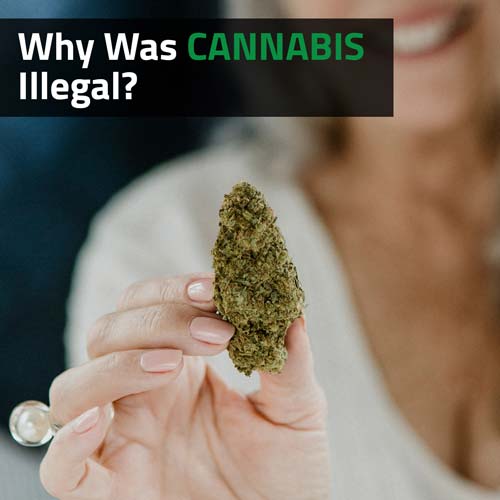Cannabis has a wide range of health benefits, which, through safe consumption, greatly outweighs any of the superstitious side effects. This is why many people are wondering why cannabis was illegal in the first place. With many conspiracies and false conclusions around this topic, here are some more conclusive answers as to why cannabis has been (and still is in many countries) illegal for such a long period.
A Short(ish) History Of Cannabis Use
Around 2 700 years ago, priests in Northwest China used cannabis for religious purposes. This is one of the first documentations of cannabis, which we know, since one priest’s tomb contained around 789 grams of marijuana neatly packed into a leather basket for his enjoyment in the afterlife. The cannabis had a very high THC content, so we also know that the oldest documentation of cannabis was purposely used as a pharmacologically active agent.
Although we do not know what the priests in Northwest China preferred as their consumption method, we have the first evidence of people smoking cannabis from the 2 500-year-old tombs in Western China. Within these tombs, cannabis residue could be found in burners that contained charred pebbles.
Onto the use of hashish, which has been utilised throughout the Middle East and Asia after around 800 AD. The increasing popularity of hashish corresponds with the spread of the Islamic religion in the area. The Quran forbids the use of specific intoxicating substances, but does not prohibit the use of cannabis.
In Europe, the ancient Yamnaya tribe is deemed responsible for bringing wild cannabis into European countries. Ancient Greek historians describe nomads in Central Asia as inhaling smoke from heated cannabis seeds and flowers in order to get high. Cannabis has made its way all over the world since these ancient times, and it is often stated that we can call it weed since it grows absolutely anywhere.
The Use Of Hemp
Hemp is one of the first plants used by humans to form textile fibres over 10 000 years ago, making it one of the first examples of an industry. Remnants of hemp cloth have been found in Iran, dating back all the way to 8 000 BC. This is proof that ancient Mesopotamians used hemp to produce fabrics.
In Europe, hemp has served as a traditional food source for thousands of years. The seeds, flowers, leaves, and extracts of the hemp plant were used as meal ingredients and food supplements for centuries. There is even a recipe in the oldest cookbook, which shows how to use cannabis nectar to create a medicinal drink.
However, hemp was still most popular in Europe for its characteristics in making cordage fibre and textiles. Evidence suggests that it was much more popular than linen in most areas. The ropes and sails of ships were created from hemp, making it an important resource for travel and warfare. Thus, hemp travelled with colonisers to every place they reached, bringing us to the main reason why cannabis became illegal.
Cannabis Comes To America
Hemp started off as a vital crop for Northern America, and the law of the land in the 1600s was to grow large amounts thereof. Early settlers encouraged the production of hemp for oil, sailcloth, clothing, and ropes. Cannabis farmers even appeared on the ten dollar bill around the 1900s. George Washington himself grew hemp at Mount Vernon, which served as one of his three primary crops.
Europeans and Anglo-Americans have had information on the medical benefits of cannabis since the 1830s. Cannabis extracts were known to ease symptoms of cholera, such as stomach pain and vomiting. Cannabis extracts were widely available in American and European pharmacies by the 19th century. Doctors even prescribed these extracts for patients with stomach aches, inflammation, migraines, insomnia, and a bunch of other ailments.
By 1853, recreational cannabis gained the label of being a “fashionable narcotic”. By the 1880s, hashish parlours made their place near opium dens in every major city on the East Coast. New York City is thought to have had at least 500 of these establishments on its own.
Cannabis Labelled As A Drug
From 1906, many states started suggesting that cannabis should be labelled as a poison, with outright prohibitions taking off in the 1920s. By the 1930s, cannabis became regulated as a drug in every single American state.
Where The Issues Started
The influx of Mexicans coming to the United States following the Mexican Revolution created significant tension between the west and southwest states. In Mexico, it had become popular to smoke marijuana as it became a cheaper alternative to alcohol due to its prohibition in the 1920s. Negative tensions spread as small and large farms started to employ Mexican workers due to cheaper labour costs.
In the midst of this tension, the Great Depression hit America, increasing tensions even further as both jobs and resources became more and more scarce. The media started to play on the fears of the public surrounding the new citizens and falsely spread racist rumours about Mexicans, among which was their use of marijuana.
The rest of the nation did not even notice that this product formed a part of their own medicine cabinets, and so, stigmas and fears around marijuana arose. The Federal Bureau of Narcotics (led by Harry J. Anslinger) was formed in 1930 as a part of the government’s aim to outlaw all recreational drugs. Anslinger claimed that the use of cannabis led to committing violent crimes and acts that were irrational or overly promiscuous (red eyes from smoking cannabis was proposed as a sign of insanity by him).
He furthered his claims by claiming that the majority of cannabis users were Mexicans, African Americans, and other minorities on which cannabis would have an intensely negative effect (around this time, minorities were viewed as “degenerate races” who could only behave negatively). Anslinger went as far as to suggest that when white women smoked cannabis, they would automatically go forth and have sexual relations with black men – a threat to their virtue at the time.
Attacks On Cannabis From Other Sides
Andrew Mellon, Secretary of the Treasury and the wealthiest man in America, made investments in a new material called nylon. His aim was to boost the success of nylon by forcing the product to replace hemp. He played on the existing fears of Americans to halt most productions of hemp by making them fear cannabis users.
At the end of the Second World War, the United Nations was established. Since the US became a superpower, Europe was influenced by the Commission on Narcotic Drugs. Cannabis was deemed as a dangerous drug with almost no therapeutic benefits – and with the big influence the US and UN had over colonised areas, the rest of the world followed suit.
This classification was by no means based on scientific evidence, but was rather produced by what was deemed as common knowledge and superstitions. This is the basic tale of how cannabis became classified as an illegal drug by most of the world.
Opinions On Cannabis Are Changing For The Better
Due to the medical benefits of cannabis, social media influence, the benefits of growing hemp, and the benefits of legalizing cannabis, opinions around the herb have started to change for the better.
Medicinal Benefits
Medical research in the 1990s proved that cannabis has a wide range of health benefits. Over the years, peer reviewed research conducted on the benefits of cannabis have shown that the herb helps to:
- Lower blood pressure
- Treating anxiety disorders
- Reduce inflammation
- Improving quality of sleep
- Treating gastrointestinal disorders
- Stimulating appetite
- Preventing relapses in drug and alcohol addiction
- Preventing seizures
- Fighting cancerous cells
People who wanted to utilise the health benefits of cannabis started using it, which started a big change on the public perception of cannabis.
-
 Brutal CBD – Litchi StrawberryR195.00 – R380.00Price range: R195.00 through R380.00
Brutal CBD – Litchi StrawberryR195.00 – R380.00Price range: R195.00 through R380.00 -
 Brutal CBD – Raspberry BlissR195.00 – R380.00Price range: R195.00 through R380.00
Brutal CBD – Raspberry BlissR195.00 – R380.00Price range: R195.00 through R380.00 -
 Brutal CBD – Pineapple PassionR195.00 – R380.00Price range: R195.00 through R380.00
Brutal CBD – Pineapple PassionR195.00 – R380.00Price range: R195.00 through R380.00
Social Media And Its Influence
With the arrival of social media in the 2000s, many individuals and companies have stepped forward to support the legalisation of cannabis and started sharing stories on how it changed their lives for the better. Decriminalization and legalisation of cannabis leads to a larger income for companies, contributions to political campaigns, and the opportunity for everyone to experience the health benefits of cannabis.
Growing Hemp Has Many Benefits
Hemp is easy to grow, does not deplete agricultural resources or grounds, uses less water, and absorbs a number of impurities from the ground. Growing hemp became a priority yet again for textiles and has helped to push away the stigma of cannabis due to the revenue it brings.
Legality Means Safety And Better Control
Legalisation of cannabis ensures that quality products are produced, prevents the probability of laced cannabis, and works better to prevent the youth from using. Making cannabis legal makes for a safer and healthier consumer product and safety-regulated products. This has led to a number of countries legalising cannabis, including South Africa.
Although cannabis seems to have a bit of a chequered past, this is mostly due to racist stereotypes, false rumours, and people trying to capitalise on the fear of the masses. We have come a long way since then, discovering the health benefits of cannabis and showing that it is not a substance that induces violence, but rather the opposite. Cannabis is legal in a number of areas in the present day, with many more following in their footsteps.







